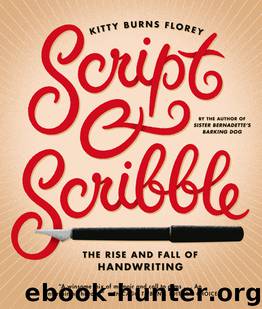Script and Scribble by Kitty Burns Florey

Author:Kitty Burns Florey [Florey, Kitty Burns]
Language: eng
Format: epub, mobi
ISBN: 978-1-61219-305-2
Publisher: Melville House
Published: 2013-09-23T16:00:00+00:00
June Etta Downey (image credits 3.9)
Professor Downey—a greatly beloved teacher who also wrote the UW alma mater—began her researches with a strong belief in the validity of handwriting analysis—her dissertation had been titled “Control Processes in Modified Handwriting: An Experimental Study.” She was intrigued by all aspects of motor behavior and by the mind-body connection. The main focus of her graphological studies was the process of writing, i.e., muscular movement, rather than the writing itself, and her graphological researches ultimately disappointed her. She found little evidence to support most trait-stroke claims (e.g., upward slants equal optimism), and wrote that a graphologist could “compare varying details with most painful exactness and yet totally miss the graphic pattern.” She championed a less “mechanical” analytic procedure—a holistic outlook—but even then was cautious because of the absence of controlled experiments.
However, while she was still a believer, she created a test known as the Downey Individual Will-Temperament Test, one of the first studies to evaluate character rather than intelligence. Her assertion that it was not useful to separate a single attribute, like intelligence, from the personality as a whole was a departure from the work of Binet and other psychologists of the day. The test employed not only graphological principles but an analysis—called a “muscle reading”—of the subjects’ movements in order to compile statistics about “will-temperament,” the term Downey devised for “volition.” Using the results, Downey—like Louise Rice—classified people into basic personality types, this time an economical three of them: the Hair-Trigger (Impulsive) Type, the Willful (Decisive) Type, and the Accurate (Careful) Type.
Downey’s interest in the somewhat vague field of “temperament testing” also encompassed the outright craziness of the Fernald Achievement Capacity Test, which was based on the idea that the longer a person can stand with his heels exactly one-quarter inch off the floor, the stronger his drive and determination; it was hoped that the test might separate young men of staunch moral fiber from budding delinquents.12
The times must have been ripe for offbeat psychological theories—this was the heyday not only of silly pseudosciences like phrenology (reading character from bumps on the head), physiognomy (reading character from facial features), mesmerism, and its outgrowth, hypnotism, but dangerous ones like eugenics.
One of the most interesting studies in graphology was done by Gordon Allport and Philip E. Vernon at the Harvard Psychological Clinic in 1930.
Download
This site does not store any files on its server. We only index and link to content provided by other sites. Please contact the content providers to delete copyright contents if any and email us, we'll remove relevant links or contents immediately.
Asking the Right Questions: A Guide to Critical Thinking by M. Neil Browne & Stuart M. Keeley(5635)
Autoboyography by Christina Lauren(5183)
Eat That Frog! by Brian Tracy(4435)
Dialogue by Robert McKee(4321)
Sticky Fingers by Joe Hagan(4101)
Journeys Out of the Body by Robert Monroe(3572)
Annapurna by Maurice Herzog(3423)
Full Circle by Michael Palin(3387)
Schaum's Quick Guide to Writing Great Short Stories by Margaret Lucke(3319)
Elements of Style 2017 by Richard De A'Morelli(3307)
The Art of Dramatic Writing: Its Basis in the Creative Interpretation of Human Motives by Egri Lajos(3015)
Atlas Obscura by Joshua Foer(2898)
The Diviners by Libba Bray(2887)
In Patagonia by Bruce Chatwin(2876)
Why I Write by George Orwell(2874)
The Fight by Norman Mailer(2848)
The Mental Game of Writing: How to Overcome Obstacles, Stay Creative and Productive, and Free Your Mind for Success by James Scott Bell(2845)
Venice by Jan Morris(2526)
The Elements of Style by William Strunk and E. B. White(2440)
